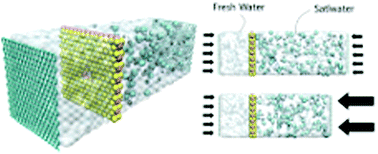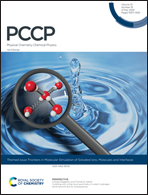Salt parameterization can drastically affect the results from classical atomistic simulations of water desalination by MoS2 nanopores†
Abstract
Water scarcity is a reality in our world, and scenarios predicted by leading scientists in this area indicate that it will worsen in the next decades. However, new technologies based on low-cost seawater desalination can prevent the worst scenarios, providing fresh water for humanity. With this goal, membranes based on nanoporous materials have been suggested in recent years. One of the materials suggested is MoS2, and classical Molecular Dynamics (MD) simulation is one of the most powerful tools to explore these nanomaterials. However, distinct force fields employed in MD simulations are parameterized based on distinct experimental quantities. In this paper, we compare two models of salt that were built based on distinct properties of water–salt mixtures. One model fits the hydration free energy and lattice properties, and the second fits the crystal density and the density and the dielectric constant of water and salt mixtures. To compare the models, MD simulations for salty water flow through nanopores of two sizes were used – one pore big enough to accommodate hydrated ions, and one smaller in which the ion has to dehydrate to enter – and two rigid water models from the TIP4P family – TIP4P/2005 and TIP4P/ε. Our results indicate that the water permeability and salt rejection by the membrane are more influenced by the salt model than by the water model, especially for the narrow pore. In fact, completely distinct mechanisms were observed, and they are related to the characteristics employed in the ion model parameterization. The results show that not only can the water model influence the outcomes, but the ion model plays a crucial role when the pore is small enough.



 Please wait while we load your content...
Please wait while we load your content...